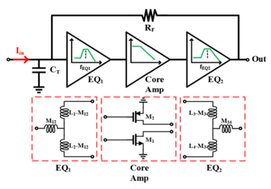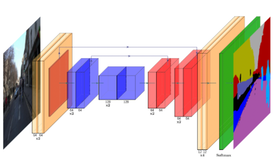Our Editor-in-Chiefs’ Top Picks
The Editor-in-Chiefs of our CASS publications have selected some noteworthy papers from the recent issues of our journals:
IEEE Open Journal of Circuits and Systems
A Low-Noise High-Gain Broadband Transformer-Based Inverter-Based Transimpedance Amplifier

by M. H. Kashani et al
Why it matters:
The proposed transformer-based bandwidth (BW) extension technique is employed to improve the BW, noise, and silicon area of inverter-based transimpedance amplifiers (TIAs) even when they use inductive peaking. The proposed technique also lowers the input-referred current noise spectrum of the TIA.
Electrical Impedance Tomography for Biomedical Applications: Circuits and Systems Review

by Y. Wu et al.
Why it matters:
This paper presents an overview of electrical impedance tomography (EIT) circuits and systems including architectures, current drivers, analog front-end and demodulation circuits, with emphasis on integrated circuit implementations. The paper also describes a number of integrated EIT systems for biomedical applications, as well as discussing current challenges and possible future directions.
A Low-Rank CNN Architecture for Real-Time Semantic Segmentation in Visual SLAM Applications

by L. Falaschetti, L. Manoni and C. Turchetti
Why it matters:
The aim of this paper is to address semantic segmentation, one of the most critical tasks for the perception of the environment, and its implementation in a low power core, by preserving the required performance of accuracy and low complexity. To reach this goal a low-rank convolutional neural network (CNN) architecture for real-time semantic segmentation is proposed.
IEEE Transactions on Circuits and Systems II: Express Briefs
L. Liu, J. Ma, X. Liao, Y. Ou, Y. Xie and Z. Zhu, "A 1.5-Cycle Fast Sampling P-SSHC Piezoelectric Energy Harvesting Interface," IEEE Transactions on Circuits and Systems II: Express Briefs, vol. 69, no. 9, pp. 3724-3728, Sept. 2022, doi: 10.1109/TCSII.2022.3181263.
https://ieeexplore.ieee.org/document/9790874
G. Bè et al., "A 900-MS/s SAR-Based Time-Interleaved ADC With a Fully Programmable Interleaving Factor and On-Chip Scalable Background Calibrations," IEEE Transactions on Circuits and Systems II: Express Briefs, vol. 69, no. 9, pp. 3645-3649, Sept. 2022, doi: 10.1109/TCSII.2022.3182217.
https://ieeexplore.ieee.org/document/9793854
3. H. Liu, L. Qi, G. Wang and Y. Liu, "A VCO-Based CTDSM With Integrated Phase Error Correction for Neural Interface," IEEE Transactions on Circuits and Systems II: Express Briefs, vol. 69, no. 10, pp. 4018-4022, Oct. 2022, doi: 10.1109/TCSII.2022.3186788.
https://ieeexplore.ieee.org/document/9810016
IEEE Transactions on Circuits and Systems for Video Technology
Haojie Liu, Ming Lu, Zhiqi Chen, Xun Cao, Zhan Ma, Yao Wang, "End-to-End Neural Video Coding Using a Compound Spatiotemporal Representation,” IEEE Transactions on Circuits and Systems for Video Technology, Volume: 32, Issue: 8, August 2022, pp.5650–5662.
https://ieeexplore.ieee.org/document/9707786
Wang Shen, Ming Cheng, Guo Lu, Guangtao Zhai, Li Chen, M. Salman Asif, Zhiyong Gao, "Spatial Temporal Video Enhancement Using Alternating Exposures," IEEE Transactions on Circuits and Systems for Video Technology, Volume: 32, Issue: 8, August 2022, pp.4912–4926.
https://ieeexplore.ieee.org/document/9648334
Axi Niu, Yu Zhu, Chaoning Zhang, Jinqiu Sun, Pei Wang, In So Kweon, Yanning Zhang, " MS2Net: Multi-Scale and Multi-Stage Feature Fusion for Blurred Image Super-Resolution," IEEE Transactions on Circuits and Systems for Video Technology, Volume: 32, Issue: 8, August 2022, pp.5137–5150. https://ieeexplore.ieee.org/document/9718302
IEEE Journal of Emerging and Selected Topics in Circuits and Systems
Donghyuk Kim, Chengshuo Yu, Shanshan Xie, Yuzong Chen, Joo-Young Kim, Bongjin Kim, Jaydeep P. Kulkarni, Tony Tae-Hyoung Kim, "An Overview of Processing-in-Memory Circuits for Artificial Intelligence and Machine Learning,” IEEE Journal of Emerging and Selected Topics in Circuits and Systems, Vol. 12, No 2, June 2022, pp. 338–353.
https://ieeexplore.ieee.org/document/9737485
Wonbo Shim, Shimeng Yu, "GP3D: 3D NAND Based In-Memory Graph Processing Accelerator,” IEEE Journal of Emerging and Selected Topics in Circuits and Systems, Vol. 12, No. 2, June 2022, pp.500–507.
https://ieeexplore.ieee.org/document/9723044
Siddhartha Raman Sundara Raman;S. S. Teja Nibhanupudi;Jaydeep P. Kulkarni, "Enabling In-Memory Computations in Non-Volatile SRAM Designs,” IEEE Journal of Emerging and Selected Topics in Circuits and Systems, Vol. 12, No. 2, June 2022, pp.557–568.
https://ieeexplore.ieee.org/document/9771423
IEEE Circuits and Systems Magazine
S. Pennisi, "Pandemic, Shortages, and Electronic Engineering," in IEEE Circuits and Systems Magazine, vol. 22, no. 3, pp. 41-49, thirdquarter 2022, doi: 10.1109/MCAS.2022.3189891.
https://ieeexplore.ieee.org/document/9880507
______________________________
JETCAS CAll for Papers: Complex Cyber-Multitudinal-Physical Systems: Analysis, Decision-Making, and AI Application
Scope and Purpose:
Modern society is greatly dependent on the efficient and safe operation of various complex networked systems, such as power systems, transportation systems, communication systems, financial systems, etc. A complex system is composed of numerous interacting components, and its overall functionality is determined by the dynamic characteristics of all the components and their interactions. With the deepening deployment of emerging technologies, real-world complex systems keep evolving and are growing into complex cyber-multitudinal-physical systems (CMPS). The word “multitudinal” indicates that new kinds of components with distinct dynamic characteristics are added to the system, whose addition can significantly change the collective behavior of the complex system from top to bottom. The words “cyber” and “physical” indicate that a cyber network is coupled and computer, control, and communication techniques are widely deployed to enhance the coordination of the physical components in the complex system. The integration of cyber and physical networks alters the interaction manners of the system components, thus changing the overall properties of the original complex system.
The classical approach to handling a complex system has resorted to mathematical and physical models, and designing classical control and optimization strategies. However, there lies a great dilemma with the classical approach: Simple models are tractable but sometimes oversimplify the mechanisms and the behaviors of complex systems which may result in non-negligible errors. On the other hand, detailed models that include more realistic features could be very complicated and often analytically intractable. Novel classical approaches are encouraged that seek an appropriate tradeoff between tractability and applicability for handling a complex cyber-multitudinal-physical system.
In recent years, the availability of big data and artificial intelligence (AI) technologies catalyze new ideas and methods to handle complex cyber-multitudinal-physical systems. In contrast to the classical approach, AI-based methods use black-box models and take advantage of massive calculations to learn from complex systems and make appropriate decisions. The cutting-edge research on applying appropriate AI technologies to the analysis and decision-making in complex cyber-multitudinal-physical systems shows great prosperity, thus drawing interest from worldwide scholars. A new research paradigm for investigating modern complex systems is very likely to be developed. In the process of establishing this new research paradigm, we should stress the appropriate use of novel AI methods and avoid random wildcard attempts of using AI techniques without a clear understanding of the capabilities and limitations of specific AI solution approaches.
To address the emerging challenges of modern complex systems and to promote the development of both novel classical and new AI-based research paradigms, we seek original papers with the latest research results and practical applications in the study of the analysis and decision-making of complex cyber-multitudinal-physical systems and the application of AI techniques.
Important Dates:
- Manuscript submissions due: 28 February 2023
- First round of reviews completed: 15 April 2023
- Revised manuscripts due: 31 May 2023
- Second round of reviews completed: 30 June 2023
- Final manuscripts due: 30 July 2023
Topics of Interest:
Topics of interest to this special issue include, but are not limited to:
- Modeling and analysis of real-world complex cyber-multitudinal-physical systems, both bottom-up and top-down methodologies.
- Control and decision-making strategies for real-world infrastructures in terms of complex cyber-multitudinal-physical systems.
- Effects of coupling of heterogeneous multitudinal subsystems on system stability and operational robustness.
- Novel stability and robustness assessment metrics and methods applicable to complex cyber-multitudinal-physical systems.
- Applications of artificial intelligence techniques to stability improvement, robustness enhancement, and operational improvement of complex cyber-multitudinal-physical systems.
- Applications of novel complex network-based analytical/control techniques to complex cyber-multitudinal-physical systems.
- Novel applications in power grids, transportation systems, economics, social networks, communications networks, and other real-world complex connected systems.
Submission Procedure:
Prospective authors are invited to submit their papers following the instructions provided on the JETCAS website. The submitted manuscripts should not have been previously published nor should they be currently under consideration for publication elsewhere.
Request for Information:
- Dr. Xi Zhang, Beijing Institute of Technology, China (Corresponding Guest Editor)
Guest Editors:
- Dr. Jiajing Wu, Sun Yat-sen University, China
- Prof. Abraham O. Fapojuwo, University of Calgary, Canada
- Prof. Zbigniew Galias, AGH University of Science and Technology, Poland
- Prof. C. K. Michael Tse, City University of Hong Kong, Hong Kong
______________________________
Latest Tables of Contents of CAS Sponsored Journals
The latest issues of our CAS sponored journals have been published and the tables of contents can be accessed through the following links:

- IEEE Transactions on Circuits and Systems I: Regular Papers
- IEEE Transactions on Circuits and Systems II: Express Briefs
- IEEE Transactions on Circuits and Systems for Video Technology
- IEEE Journal on Emerging and Selected Topics in Circuits and Systems
- IEEE Circuits and Systems Magazine
- IEEE Transactions on Biomedical Circuits and Systems
- IEEE Design and Test Magaz
- IEEE Open Journal of Circuits and Systems